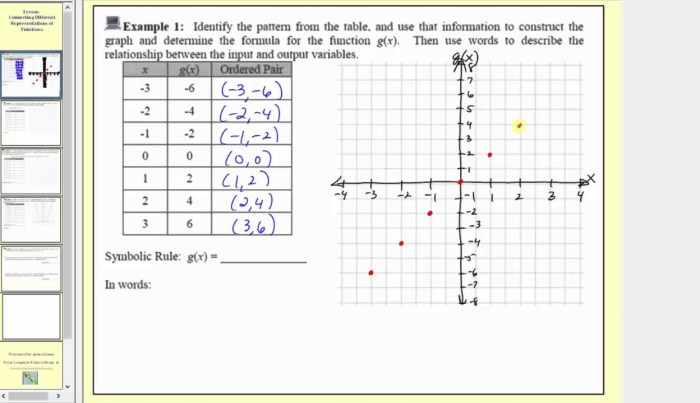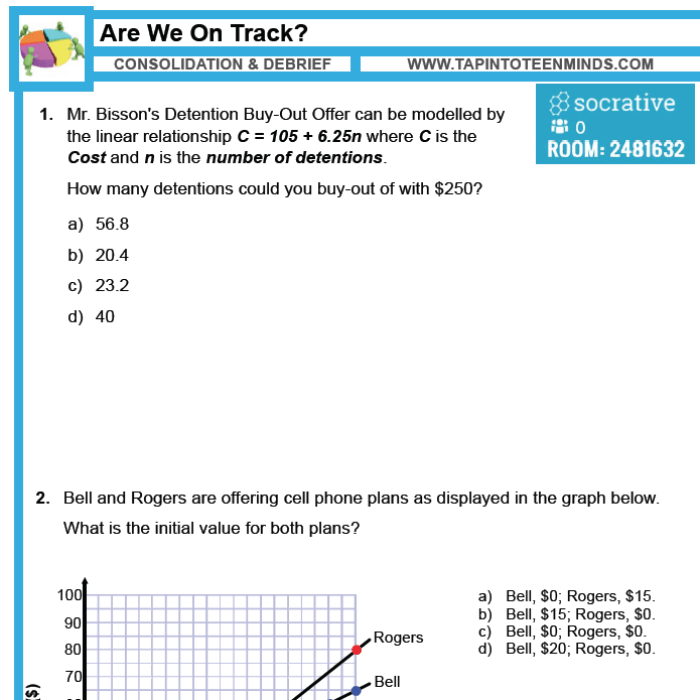The Multiple Representations Homework 7 Answer Key is an invaluable resource for students seeking to master the art of solving complex problems using diverse representation methods. This guide provides a comprehensive overview of multiple representations, their advantages and disadvantages, and step-by-step instructions for their effective application.
By exploring the cognitive benefits and problem-solving enhancements offered by multiple representations, this guide empowers students to excel in their academic pursuits and beyond.
Multiple representations offer a versatile approach to problem-solving, allowing students to visualize and manipulate information in various formats. From diagrams and graphs to equations and tables, each representation provides a unique perspective, fostering a deeper understanding of the underlying concepts.
This guide delves into the specific types of multiple representations used in Homework 7, highlighting their strengths and limitations to equip students with the necessary knowledge for effective problem-solving.
Multiple Representations in Homework 7

Multiple representations are different ways of representing the same mathematical concept or problem. In the context of Homework 7, multiple representations can include diagrams, tables, graphs, equations, and verbal descriptions.
The purpose of using multiple representations in Homework 7 is to provide students with different ways to access and understand the mathematical concepts being taught. By using multiple representations, students can develop a deeper understanding of the concepts and be able to apply them to a wider range of problems.
Types of Multiple Representations
There are many different types of multiple representations that can be used in Homework 7. Some of the most common include:
- Diagrams: Diagrams can be used to represent relationships between objects or concepts. For example, a diagram could be used to show the relationship between the different parts of a fraction.
- Tables: Tables can be used to organize data and information. For example, a table could be used to show the different values of a function for different inputs.
- Graphs: Graphs can be used to represent relationships between variables. For example, a graph could be used to show the relationship between the distance an object travels and the time it takes to travel that distance.
- Equations: Equations can be used to represent mathematical relationships. For example, an equation could be used to represent the relationship between the area of a circle and its radius.
- Verbal descriptions: Verbal descriptions can be used to explain mathematical concepts and problems. For example, a verbal description could be used to explain the steps involved in solving a particular type of problem.
Each type of multiple representation has its own advantages and disadvantages. Diagrams are often helpful for visualizing relationships between objects or concepts, but they can be difficult to create and interpret. Tables are good for organizing data and information, but they can be difficult to read and understand.
Graphs are good for representing relationships between variables, but they can be difficult to create and interpret. Equations are good for representing mathematical relationships, but they can be difficult to solve. Verbal descriptions are good for explaining mathematical concepts and problems, but they can be difficult to remember and apply.
Using Multiple Representations in Homework 7
To use multiple representations effectively in Homework 7, it is important to choose the representations that are most appropriate for the problem being solved. For example, if the problem involves relationships between objects or concepts, then a diagram might be the best representation to use.
If the problem involves data or information, then a table might be the best representation to use. If the problem involves relationships between variables, then a graph might be the best representation to use. If the problem involves mathematical relationships, then an equation might be the best representation to use.
If the problem involves explaining a mathematical concept or problem, then a verbal description might be the best representation to use.
Once the appropriate representations have been chosen, it is important to use them effectively. This means using the representations to communicate the mathematical concepts and problems clearly and concisely. It also means using the representations to help students understand the concepts and problems and to solve them.
Benefits of Using Multiple Representations
There are many benefits to using multiple representations in Homework 7. Some of the benefits include:
- Improved understanding: Multiple representations can help students to develop a deeper understanding of mathematical concepts and problems.
- Increased problem-solving skills: Multiple representations can help students to develop problem-solving skills by providing them with different ways to approach problems.
- Enhanced communication: Multiple representations can help students to communicate mathematical concepts and problems more clearly and concisely.
Overall, using multiple representations in Homework 7 can help students to learn mathematics more effectively and efficiently.
Examples of Multiple Representations in Homework 7, Multiple representations homework 7 answer key
| Problem | Multiple Representations | Solution |
|---|---|---|
| Find the area of a circle with a radius of 5 cm. | Diagram of a circle, equation for the area of a circle (A = πr^2), table of values for the area of a circle with different radii | The area of the circle is 25π cm^2. |
| Find the slope of the line that passes through the points (2, 3) and (5, 7). | Graph of the line, equation for the slope of a line (m = (y2
|
The slope of the line is 1. |
| Solve the equation x^2 + 5x + 6 = 0. | Graph of the equation, table of values for the equation for different values of x, equation for the solutions to the equation (x =
|
The solutions to the equation are x =
|
FAQ Insights: Multiple Representations Homework 7 Answer Key
What is the purpose of multiple representations in Homework 7?
Multiple representations in Homework 7 provide diverse perspectives on complex problems, allowing students to visualize and manipulate information in different formats to enhance understanding and problem-solving.
How can multiple representations improve problem-solving skills?
Multiple representations foster critical thinking, encourage the exploration of alternative solutions, and enhance the ability to connect different concepts, leading to improved problem-solving outcomes.



